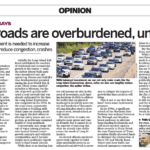The following was written by Karl Grossman for the Southampton Press, the East Hampton Press, the Shelter Island Reporter, the Sag Harbor Express, the Community Journal and the South Shore Press. The original can be read here. Richard Murdocco, author of the Foggiest Idea, was quoted alongside environmentalists.
Not since 50 years ago has there been such a major push for sewering in Suffolk. The drive back then was led by construction interests which wanted the sewer work, development interests that wanted the increased density a switch from cesspools to sewers would allow, Newsday which editorialized ceaselessly for sewers, and Suffolk County Executive H. Lee Dennison, an engineer who believed sewers the solution for handling waste.
Used repeatedly in the drive was a full-page ad featuring a toilet bowl and the message that drinking water would be contaminated with the stuff that toilet bowls contain without what was to be the start of large-scale sewering in Suffolk: the Southwest Sewer District.
I recall Shelter Island Supervisor Evans K. Griffing, chairman of the Suffolk County Board of Supervisors, blasting the toilet bowl ad as “unbelievable,” opposing the project and later decrying how “the pressure was brought on by Newsday… They touted it up no end, and finally a hysteria developed and people [in the proposed district] voted for it.”
With federal and state governments paying the lion’s share, the project ended up costing over $1 billion in 1970s dollars. In a county long riddled with corruption, it became one of Suffolk’s biggest scandals. There were indictments and convictions. Mr. Dennison’s successor as county executive, John V. N. Klein, lost office as a result.
Now we aren’t met with a toilet bowl ad. The focus is on nitrogen from waste that has been migrating into our waterways, seen as causing brown and red tides, killing marine life and causing other damage. As the current Suffolk County executive, Steve Bellone, has declared: “Nitrogen pollution is public enemy No. 1 for our bays, waterways, drinking supply and the critical wetlands and marshes that protect us from natural disasters like superstorm Sandy… More than 350,000 homes in Suffolk County are not sewered and are contributing nearly 70 percent of the pollution.”
Significantly expanding sewers in Suffolk was stymied post-Southwest Sewer District because large amounts of federal and state tax dollars were no longer available for sewers. In recent times that changed and big bucks are here again. The Bellone administration has gotten $383 million in U.S. and state money for new sewers. Newsday has reported that it will take $9 billion for “completely sewering Suffolk.”
Meanwhile, County Legislator William Spencer of Centerport proposed this month a county referendum to increase the 8.6 percent sales tax in Suffolk to expand sewering.
And last month, Mr. Bellone named Peter Scully, who’s been Long Island regional director of the state Department of Environmental Conservation, to be county sewer czar.
Is the new push all about nitrogen in our waterways? And is sewering the best way to deal with this? As decades ago, when Mr. Griffing (and many others) spoke out, there are those challenging the Suffolk sewer drive.
“It’s a very dangerous path,” says Kevin McAllister, founder and president of the Sag Harbor-based group Defend H20. “Mr. Bellone, in particular, has been pushing sewering for economic development under the guise of clean water.” The recent marine life deaths again demonstrate “we have to clean up the bays,” says Mr. McAllister, a Center Moriches native ,long involved in protecting the marine environment. But nowadays as an alternative to sewers there are “advanced denitrification systems that can be installed in individual homes and on a community basis.” They’re less expensive, and “all but eliminate” nitrogen in waste. Suffolk government, however, has only begun considering “at a snail’s pace” these high-tech systems that are a technological advancement over sewers. Moreover, sewers “are tied to dramatic increases in housing density. Thus if sewering allows 100 housing units to become 1,000, that negates the benefits of sewage treatment.”
Bill Toedter, president of the North Fork Environmental Council, asks: “If sewering ‘solves’ the nitrogen pollution issue, then why are all of the bodies of water around Nassau County, which is over 90 percent sewered, some of the worse polluted waters on Long Island?” He also points to the high hook-up costs for those sewered and subsequent fees and the 6-to-10 year time for sewer completion compared to swift installation of denitrification systems. Mr. Toedter, too, emphasizes the “added development” brought on by sewers, their “promoting densities of population we cannot support.”
Richard Murdocco, who studied planning at Stony Brook University, has a master’s degree in public policy from there and writes “The Foggiest Idea” blog (www.thefoggiestidea.org), has analyzed the county’s newly released 1,040-page “Comprehensive Water Resources Management Plan.” He notes: “The current plan stresses the importance of reducing nitrogen but it doesn’t emphasize enough the ‘soft’ solutions, such as the most effective water protection tool, preserving open space or designing green buildings and pushing for tougher zoning. Instead, the plan focuses on sewers, and their relative effectiveness in achieving nitrogen reduction. The push for sewers reveals,” says Mr. Murdocco, citing a line in the middle of the plan, “the county’s true intentions: ‘stimulate development in order to promote economic growth and stability.’”













